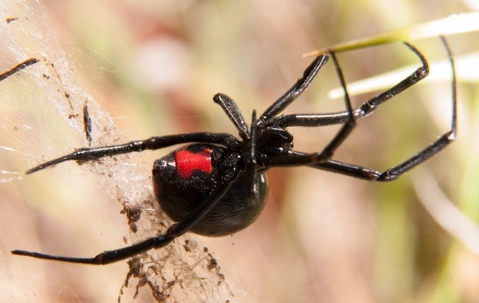Of all the pests you could encounter in your St. Louis home, some of the most feared are spiders. Many people find them hard to look at and are worried that they will be bitten. While all spiders do have venom, most spiders aren’t dangerous to humans. In fact, there are only two species in the United States that are considered medically dangerous: black widows and brown recluse spiders.
While it can be upsetting to see spiders in your home, most common household spiders are unlikely to bite you, and, even if they do, the bites are unlikely to harm you. However, if you notice a brown recluse or black widow in your home, it is cause for concern as their bites can be serious. Regardless of the species, spiders in your home aren’t a welcome guest, and you’re likely looking to remove them right away. The first step in spider prevention and removal is to know the different species in the area and how to tell them apart.
Here is a guide to common area spiders:
Black Widow
This dangerous spider is easy to identify because of its jet black color and the red hourglass shape on its abdomen.
Brown Recluse
This is another dangerous spider that is a light brown to dark brown color. They are best identified by the violin-shaped mark behind their heads.
Cellar Spider
These spiders are usually found in dark, damp areas. They are a pale yellow or grey color and long, extremely thin legs.
Funnel-Web Spider
Commonly known as the hobo spider, this species is brown with dark stripes that run down its back. While they can be aggressive, they aren’t dangerous.
Wolf Spider
This is an extremely common species in Missouri. Then vary in color and can be grey, brown, black, or tan. They have dark brown or black markings and are known for hunting down their prey which makes them particularly fast runners.
The First Step In Spider Prevention
Because spiders are so off-putting and, in some cases, dangerous, keeping them out of your home is essential. The first part of keeping spiders out is to address the underlying issues that draw them inside in the first place.
Unlike other pests that often go inside looking for shelter or escape from extreme weather, most spiders go indoors in search of their prey. So, if you have other infestations of small pests, this could be leading to more spiders.
Here are some of the best ways to prevent spiders and their prey:
- Store food in airtight containers when possible.
- Make sure pet food is kept in containers with lids.
- Declutter often.
- Remove any webs.
- Sweep and vacuum often.
- Address excess moisture by fixing leaky pipes and faucets.
- Ensure that basements and crawlspaces are well ventilated.
The Second Step In Spider Prevention
After addressing things that could be attracting spiders and their insect prey, the next step in prevention is to make it harder for spiders to get inside. This means doing what you can to seal off entry points where spiders can sneak inside.
Here are some ways to keep spiders out of your home:
- Repair holes in window and door screens.
- Install door sweeps on exterior doors.
- Place weather stripping around doors and windows.
- Seal up cracks in your home’s foundation.
- Ensure that doors and windows are fitted tightly in their frames.
- Put mesh screens over air vents.
Get Help With Spider Infestations
If you’ve noticed an influx of spiders around your St. Louis home, the best way to get help with spider prevention and removal is to contact the experts at Arenz Pest Management Solutions, Inc. Our trained technicians have 20 years of experience in the area and can treat spider infestations as well as other pest problems that could be attracting them. Give us a call today to learn more or to get started protecting your home from spiders.
Tags: spider identification | spider prevention | spiders in st louis |
Call Now To Start Protecting Your Family
Complete the form below to schedule your no obligation inspection.

